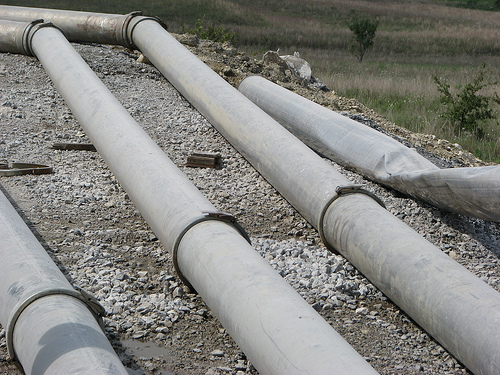
The Vanguard has learned that residents in the West Davis neighborhood of Stonegate have experienced a series of gas leaks as the result of aging pipelines that apparently PG&E has known to be a problem since the early 1980s.
According to a news release from residents, “PG&E has admitted to homeowners in far west Davis that there is a documented problem with gas leaks in its plastic pipe distribution lines.”
On October 27, PG&E representatives agreed to replace the plastic distribution lines in the Stonegate subdivision, but no timetable has been provided.
Residents report that in a one block area on Marina Circle in Stonegate, there have been six gas leaks in the last 18 months. On October 31, PG&E found and repaired four additional leaks in the Stonegate area. PG&E is continuing its inspection of gas lines in the area.
Mayor Joe Krovoza told the Vanguard this morning that he has been briefed by PG&E on their meetings with affected residents.
“PG&E is also in contact with city staff, especially with Fire Chief Weisgerber,” the Mayor said. “I have every expectation that the city will continue to follow this as PG&E works with their customers, and I expect PG&E to be fully transparent with our community regarding the situation.”
The Vanguard has a call into PG&E as well, and will update this article with further information as needed.
According to the residents, PG&E has told them that the plastic gas pipe is predominately Aldyl A, manufactured by DuPont.
Stonegate residents have requested from PG&E a GIS (Geographic Information System) map of all reported gas leaks to determine the location of the leaks, but, to date, PG&E has not provided this data. PG&E has also not provided information on how many leaks have occurred in the last few years.
“This is a public safety issue, not a public relations issue,” said David Johnson, a neighborhood spokesperson who has experienced two recent gas leaks on his property. “We need to notify homeowners where known trouble spots are located. If there is a cluster of historical gas leaks in a certain area, residents need to be notified as soon as possible.”
The Vanguard spoke to Fire Chief Bill Weisgerber this morning.
“Anytime there’s a gas leak and there’s a source of ignition, you can have a problem,” the Chief told the Vanguard this morning. “I know everyone is thinking the San Bruno transmission line, but these are actually the smaller, what they call distribution lines, they’re probably two-three inches in diameter.”
“Even those do present a problem if they start to leak,” the Chief said. “But typically it’s a less severe risk -you aren’t as likely to see an explosion.”
The Stonegate Homeowners’ Association is planning a community forum to discuss this issue at a future date. PG&E will present information at the forum on its plan to replace the faulty pipes.
Chief Weisgerber noted that they will be replacing the older lines first and then incorporate it into the larger plan for the state where they will be replacing more than 1200 miles of old and outdated pipeline.
Chief Bill Weisgerber said that, while he does not have any statistics, he does believe the problem right now is clustered in the Stonegate area.
“I think they are experiencing a high frequency in the Stonegate area,” he said. However, there are about 1200 miles of that age and composition of pipe called Aldyl A.
The San Francisco Chronicle reported recently that “Aldyl A gas pipes have been linked to one explosion and one fire in Northern California in the past 8 weeks.”
On August 31, a condominium in Cupertino was destroyed by a gas leak from an Aldyl A pipe leak.
On September 27, an Aldyl A pipe ruptured in Roseville, sparking a fire at a commercial intersection that burned for seven hours and forced a 12-hour shutdown of the street.
One point that should be made clear, these are very small pipes, in general less than two inches in diameter, a far cry from the 30-inch pipeline that ignited and exploded in San Bruno.
Nevertheless, this is a serious safety issue. Aldyl A pipe made before 1973 has been known for nearly 30 years to be vulnerable to cracking and sudden failure.
As early as 1982, DuPont notified PG&E that about 30% of the pipes it made in the early 1970s could become brittle and crack prematurely under certain conditions, such as being placed in rocky soil.
Aldyl A has been the subject of two federal safety advisories and several lawsuits stemming from accidents across the country.
The National Transportation Safety Board has recommended that utility operators locate potential problems and replace those lines. PG&E has 1,231 miles of pre-1973 pipe and 5,800 miles of newer Aldyl A in its distribution system.
The news release also noted that “Residents should be aware that natural gas is odorless but PG&E places a sulfur based chemical in the gas for detection purposes.”
Davis Fire Chief Bill Weisgerber said, “Residents should remember if they do smell gas they should immediately call 911 and evacuate the premise.”
People should move to a safe area outside of the house and call the fire department. They will bring gas detection equipment and determine the source of the leak.






Is there any device on the market that detects gas leaks inside a home?
From [url]http://www.puco.ohio.gov/puco/index.cfm/consumer-information/consumer-topics/natural-gas-safety/[/url]
[quote]Gas Line Leaks
While rare, natural gas line leaks can be extremely dangerous. The most telling sign of a natural gas line leak is the familiar rotten egg odor the natural gas coming into the home has. This odor is added to the natural gas so it can be detected in the event of a leak.
The biggest hazard of a gas leak is an explosion. When natural gas builds up in an enclosed area, it becomes extremely volatile. A gas build up has the potential to be explosive, or could make those in the area very sick. Gas leaks in the home can be easily prevented by ensuring flexible gas lines are inspected regularly and installed properly by licensed professionals.
Gas leaks outside the home are dangerous as well. Most gas lines coming into the home are buried underground. Before doing any job that requires digging outside, homeowners should call the OhioUtilities Protection Service at (800) 362-2764 at least 48 hours before digging. The utilities will be contacted and asked to mark the lines they own. After the lines have been marked, safe, careful digging can begin.
If you detect a strong gas odor, follow these tips:
Do not attempt to locate the leak.
Do not turn on or off any electrical appliances.
Do not smoke or use any open flames.
Leave the house and, from a safe distance, call the utility company and 9-1-1.
When digging outside, if a natural gas line is damaged, call the utility immediately. Do not attempt to repair the line.
By following these safety tips, natural gas can continue to be a safe and efficient source of energy for the home.[/quote]
Elaine… three good detection devices that are readily available… human nose… canine nose… feline nose… the mercaptans that are used to “odorize” natural gas tend to be very noticeable if they are not consumed in flame (stoves, gas dryers, gas fireplace inserts, etc.). Because of the mercaptans, the natural gas, when leaking into soil, may turn the soil color to a greenish-blue, or bluish-green. In Davis, call 811 before you or your contractor digs… saves you from being responsible for damage to gas, electrical, CATV or other underground utilities that may be present… also may save your life…
A PG&E field worker once told me that the grass near an outdoor leak was dying because the gas in the soil reduced the oxygen. But the same guy also told me there was nothing to worry about because the leak was outside (about 10 feet from a building), not inside…..
[quote]Elaine… three good detection devices that are readily available… human nose… canine nose… feline nose…[/quote]
The problem w relying on “the nose” is that it can become accustomed to a smell after breathing it in for a while. Secondly, some people have a notoriously bad sense of smell. Thirdly, dogs and cats cannot necessarily “speak” to their owners to tell them there is a gas leak. That is why I asked if there was actually a detection device of any sort. I tried to research the issue, but found nothing. It’s funny that we have carbon monoxide detectors, but not a detector for gas leaks…